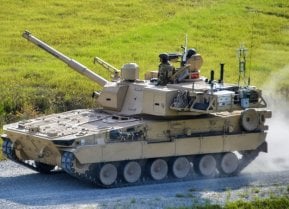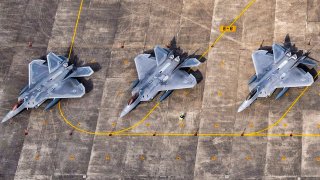The F-22 Raptor Is the Most Expensive Fighter Ever and Could Be Retired
The F-22 Raptor is the most expensive warplane in America’s arsenal. It is also considered by many experts to be the most advanced fifth-generation warplane in the world. Sadly, the Raptor is nearing retirement.
Summary: The F-22 Raptor, renowned for its advanced capabilities and considered the most expensive and advanced fifth-generation warplane, is nearing retirement. That seems like a mistake.
F-22 Raptor: A Sad History
The F-22 Raptor is the most expensive warplane in America’s arsenal. It is also considered by many experts to be the most advanced fifth-generation warplane in the world. Sadly, the Raptor is nearing retirement. This, at a time when threats to the United States are ramping up and when the F-22 is needed now more than ever.
And why is the Raptor being retired? After all, the warplane never reached the level that its designers had intended for it to reach. The F-22 Raptor program was prematurely cut by a short-sighted Obama Administration that instead favored the F-35 Lightning II, America’s other fifth-generation warplane, over the F-22.
Citing budgetary concerns, the Obama Administration believed it needed to make a choice between continuing the US government’s support for the F-22 Raptor or the F-35 Lightning II. The Raptor was an Air Force project that was intended to replace the existing USAF fourth-generation air superiority fighters. The Pentagon was looking for a multi-role warplane that could be used by multiple services. The F-35, unlike the F-22, was designed to be used by the Air Force, Navy, and the Marines. Plus, the F-35 was meant to be used—and is—by the air forces of allied nations, thereby increasing the all-important interoperability among the US military and its allies.
Obama Prematurely Killed the F-22
Because the F-22 was so dynamic and innovative, the warplane was never available for sale to allied militaries. While there was initial discussion about the Navy developing its own version of the F-22 for carrier launches, the program never got off the ground (if you’ll pardon that cringeworthy pun).
So, the F-22 was a massively expensive program that was being used by only one branch. And, to make compound problems, there weren’t many units available to the Air Force of the F-22 (because the price tag for the F-22 was so high).
Yet, by the time it was cut by the Obama Administration, the Raptor was reaching a production tempo that would have likely seen it achieve the goals its original designers had in mind for the plane. What’s more, had the Obama Administration not cut the F-22, it is likely that the Air Force would have the world’s greatest air superiority warplane in abundant numbers today. This, by the way, is a warplane that continues to fly rings around other fifth-generation warplanes belonging to rival nations, such as China’s knockoff, the J-20 or Russia’s problematic Su-57.
Already, the Air Force has started to “shed” what they claim to be antiquated F-22 Raptors. According to the Air Force, this year America’s air service will decommission a whopping 32 Block 20 F-22 Raptors. There are a total 183 F-22s in service today. That is far below the intended number, which was set to be 750, which was to replace the Air Force’s aging F-16C warplane on a one-for-one basis. But that number was conceived way back in 1991, when the Cold War was still in the process of ending and the Soviet Union had yet to totally implode. Once the Cold War ended with a bloodless US victory, everything changed in terms of the way that US policymakers viewed American strategic needs (and not for the better, mind you).
The F-22 was Meant to Win World War III
The Raptor was designed to fight—and win—a dogfight with the best warplanes the Soviet Air Force could muster. The F-22A is “a supersonic, dual-engine fighter jet, which won the 2006 Robert J Collier Trophy from the American National Aeronautic Association (NAA).” Possessing a “radar cross-section the size of a marble,” this warplane is also highly maneuverable. In fact, its thrust capabilities are so great that it is probably the most difficult plane for enemy fighters to kill in a dogfight.
When the fifth-generation warplane was conceived in the late 1980s and early 1990s, the Pentagon’s brass initially envisaged the F-22 being used in mixed squadrons alongside the F-35 Lightning II. Both planes are stealthy and have incredible defense systems. Yet, the F-22 is far better at dogfighting than the F-35 is whereas the F-35 is a better bomber. With the F-22s providing protection for the F-35, the combination of these two fifth-generation warplanes providing the knockout punch to America’s enemies in any air campaign was great. Further, the F-22 possesses communications capabilities and provides greater overall situational awareness for its pilots than any other platform in service today that it is truly a kickass plane.
Given the rising threat of great state rivals, such as China and Russia, or the growing risk that rogue states, like Iran and North Korea, pose to the United States—and the fact that the F-22 Raptor continues to outclassanything these nations can field against American forces—it might be a worthwhile investment to reinvest in the F-22.
A great power conflict is upon us.
The Air Force and other branches are still dreaming of tomorrow wars and the kind of wünderwaffe that US taxpayers and politicians will lavish them with. These war fantasists are wrong. The war is coming far sooner than expected and they will have to go to war with the military they have, not the one they wish they had. Rather than trying to reinvent the wheel or blow their budget on this ridiculous sixth-generation warplane, the Air Force should spend whatever it must to reconstitute the F-22 program and get the numbers of its fighters to the original level of 750 units.
Detractors of this move claim each F-22 would cost $200 million. But that number would come down the more planes were built. This was the case with the initial builds of the F-22.
After all, in every wargame scenario with China’s air force, the F-22 dominates the battlespace whenever it is introduced. We need more of these systems. Reconstituting this prematurely killed program would both enhance American security and likely allow for the US Air Force to win a war that it is thus far slated to have difficulty winning.
About the Author
Brandon J. Weichert is a former Congressional staffer and geopolitical analyst who is a contributor at The Washington Times, as well as at American Greatness and the Asia Times. He is the author of Winning Space: How America Remains a Superpower (Republic Book Publishers), Biohacked: China’s Race to Control Life, and The Shadow War: Iran’s Quest for Supremacy. Weichert can be followed via Twitter @WeTheBrandon.


